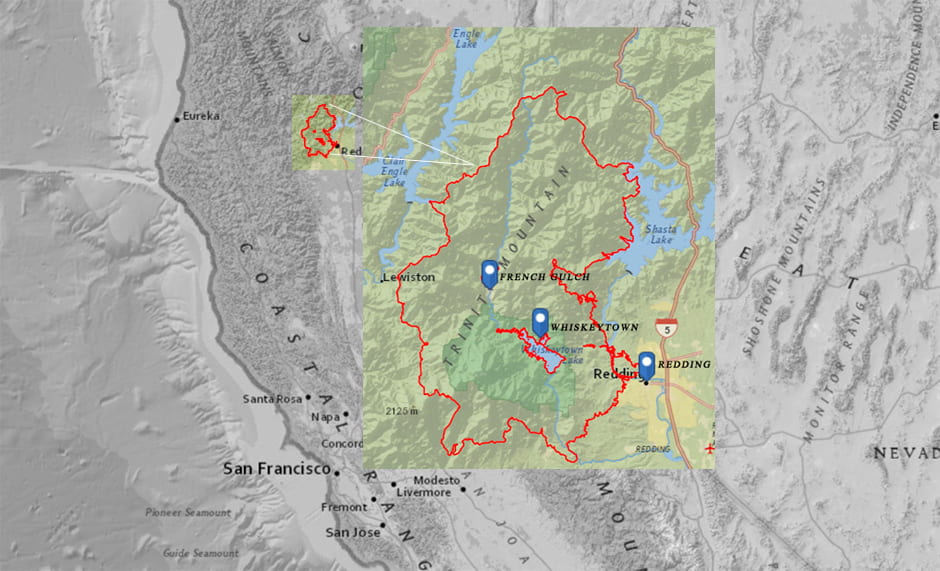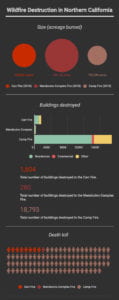Around 1:15 pm on July 23, 2018, sparks ignited on the side of the road on Highway 299. This stretch of highway borders Whiskeytown Lake, beautiful and lush on the 249 days a year when it doesn’t rain in Shasta County, California, 160 miles north of Sacramento. (Now, the hills are burnt to a crisp. It will take decades to regrow the flora.)

Fire perimeter data from Redding ArcGIS, map created using ArcGIS.
The Carr Fire was named after the intersection where it began — near the Carr Powerhouse Road. According to CALFire, a mechanical car failure ignited the first sparks, and the fire soon spread.
It was a small fire, and at first gained ground only moderately. On its website, the NPS says that it wasn’t until July 24 that “significant fire growth occurred.”
On July 26, the fire exploded overnight. A fire whirl (colloquially known as a fire tornado, though true fire tornadoes are far more dangerous and rare) jumped the Sacramento River. This carried the fire into Redding, a city of 90,0000 10 miles away from Whiskeytown. The NPS called the fire’s activities on this day and the day before “extreme fire behavior,” with the fire rapidly expanding and calls for evacuation happening quickly.
This “fire tornado” was extraordinary, dangerous and incredibly unpredictable. The San Francisco Chronicle called it “something monstrous: a fire tornado the likes of which the state had never seen.” It was a flaming fire vortex (stronger than a whirl), a funnel of flame and ash and wind that reached tornado-like strengths of 143 miles per hour. The temperatures inside this colossal 17,000-foot vortex reached a scorching 2,700 degrees Fahrenheit.
The fire only grew rapidly from there, with evacuation totals reaching over 38,000 on July 28, according to KTLA.
Associated Press photos.
The Carr Fire moved faster than people expected. Evacuations were hurried, and sometimes people barely made it out in time. Zita Biehle recalls not getting an evacuation order until she could see the flames. There was one way out of the neighborhood where she lived, the Lake Keswick Estates neighborhood of Redding. The traffic was backed up, and she recalls telling her kids to “pray because that’s the only way we’re getting out of here.”
“You could feel the heat,” Biehle said, of the time she was evacuating, “I just knew it was coming, I ran in the house, started grabbing some stuff and my phone went off to tell me, at the same time the police were on the street, ‘Mandatory evacuation get out, no trailers.’”
She added: “That was the only warning that we had as we were in the house… at that point, already, just flames the bottom of the street. That’s how fast it happened. The flames were already there.”
And Laura Sanford, who lives in nearby French Gulch, was able to evacuate because her son, Rick Thompson, was fighting the Carr Fire and called her in advance to let her know the fire looked like it was heading in her direction.
By the time the fire was 83 percent contained on August 19, whole swaths of Redding neighborhoods were gone, as were the hills in Whiskeytown, and half the historic town of French Gulch, and all but two houses in Keswick, and so many more spots in between.
The fire was fully contained on August 30. At that point, 8 people had died and 1,604 buildings had been burned to the ground. 211 other buildings sustained damage. 229,651 acres burned. In total, the Carr Fire cost more than $1.6 billion in damages — that’s including insurance claims and in firefighting costs.
The Carr Fire, though incredibly destructive, was not even the most devastating fire in California’s 2018 fire season.
All data from CALFire. Created using Infogram.
The summer of 2018 was a dry, hot and fire-heavy season for northern California. From July to August, two fires raged and destroyed within 200 miles of each other: while the Carr Fire burned in Shasta County, the Mendocino Complex fire — made up of two fires, the Ranch Fire and the River Fire — burned over 459,000 acres, according to CALFire. That makes it the biggest fire complex in the state’s history.
And just two months later and two hours south of the Carr Fire, the Camp Fire devastated entire towns in November 2018. Paradise, just 85 miles away from Shasta County, was left on the ground. 85 people died, 18,793 buildings were destroyed and 153,336 acres burned in the deadliest and most destructive wildfire in California history.






